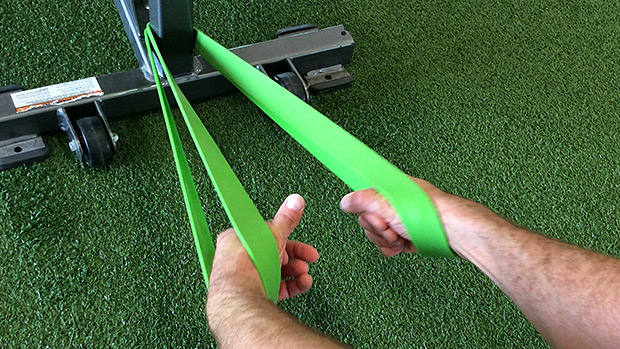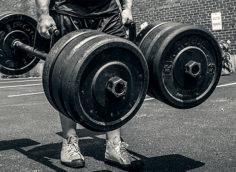After a while, doing the big compound lifts takes its toll on the back. Even if you have impeccable form, your back will still get compressed with repeated spinal loading.
If you find yourself feeling beat up and in need of a great spine "opener," try out this banded spinal decompression stretch.
You need two bands. One band should have one end tied to an anchor and the other end wrapped around your hips.
The second band should have one end tied to another anchor and the other end hooked around the wrist bones. I recommend putting the band on the wrist bones instead of grabbing it with your hand because it'll be easier to relax into the stretch if your forearms don't get fatigued from holding the band.
Here's where you should place the bands on your wrists:

Note: I put a couple heavy kettlebells on the bench so it wouldn't slide forward.
You can add small movements throughout this stretch to emphasize the area you want to focus on. If you feel your lats need more attention, rotate your core to feel the stretch run through the sides of the body.
If you need some relief on your low back, move your hips from side to side and feel a gentle stretch running through your lower spinal erectors.
Don't do this stretch before or during your heavy lifts. This will put you into a relaxed state which isn't exactly ideal if you need to crank up the intensity on heavy squats or deadlifts. Do this stretch after lifting.
It could also be added as a recovery exercise on your off days for pain relief or mobility purposes.
Between each vertebrae are intervertebral discs. These discs act as a cushion and shock absorber so that the vertebrae don't compress and grind on one another. With age or continued heavy spinal loading, these discs can potentially bulge causing pressure to be placed on the nerves in your spine. And that leads to a lot of pain.
Since your intervertebral discs are cartilage, they don't contain a blood supply. This is why it could be beneficial for pain relief to "rehydrate" these discs with decompression from time to time.
The banded decompression stretch works by placing a gentle stretch on your entire spine allowing fluid containing oxygen, water, and nutrients to refill the discs in your back. This essentially rehydrates your discs so that they can do a better job of cushioning your vertebrae.
This stretch is very similar to the "downward facing dog" you'd perform in a yoga class, except that it uses bands to place slight distraction on the spine and shoulders.




